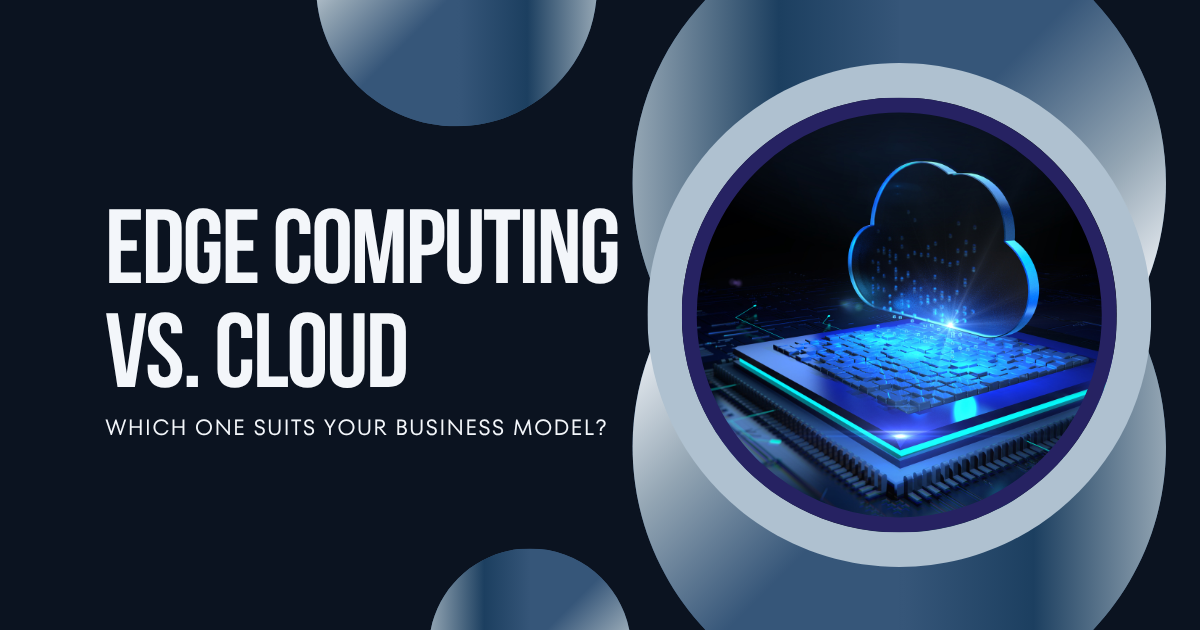Edge Computing vs. Cloud: Which one suits your business model?
Data powers modern businesses, and where you process it shapes your success. Edge computing vs cloud defines two paths: one prioritizes speed and local processing, the other scalability and centralized power. This article breaks down their differences, benefits, and use cases to guide your business toward the right choice.
Table of Contents
Edge Computing and Cloud Computing
To make an informed choice between edge vs cloud computing, it’s essential to grasp their core concepts.
Cloud computing involves running workloads in clouds—software-defined environments created by data centers or server farms. Businesses access scalable, on-demand resources over the internet, making it ideal for tasks like big data analytics, machine learning, or collaborative tools. It centralizes processing, offering flexibility and accessibility from anywhere with an internet connection.
Edge computing brings computation and storage closer to the data source or user. By running workloads on edge devices, such as IoT sensors or local servers, it reduces latency and bandwidth usage. This approach is particularly suitable for real-time applications where speed is crucial, such as autonomous vehicles or industrial automation.
Edge computing benefits
Edge computing offers distinct advantages, making it a compelling choice for specific scenarios. Here are the key edge computing benefits:
- Reduced latency: Processing data locally ensures near-instant responses, which is crucial for applications such as remote surgery or self-driving cars.
- Bandwidth savings: Only processed results are sent to the cloud, cutting data transfer costs, especially for high-volume data.
- Improved reliability: Edge systems function independently of cloud connectivity, ensuring uninterrupted operations.
- Enhanced security: Keeping sensitive data local reduces exposure during transmission, which is crucial for industries such as healthcare.
- Real-time analytics: Immediate data processing enables faster decision-making, boosting operational efficiency.
These benefits make edge computing a game-changer for businesses prioritizing speed and local processing.
Real-world use cases of edge computing
are some real-world use cases of edge computing that showcase its versatility:
- Autonomous vehicles: Self-driving cars process sensor data instantly to make split-second decisions, ensuring safety and efficiency.
- Industrial IoT: Manufacturing plants use edge devices to monitor equipment in real-time, predicting maintenance needs and optimizing production.
- Retail: Smart shelves track inventory and customer interactions, providing store managers with immediate insights.
- Healthcare: Remote monitoring devices analyze vital signs on-site, alerting medical staff to anomalies without delay.
- Smart cities: Traffic systems adjust signals based on real-time conditions, reducing congestion and improving flow.
These edge computing use cases demonstrate its ability to address specific industry challenges effectively.
Cloud computing in modern businesses
Cloud computing in modern businesses has transformed operations by offering scalability, flexibility, and cost-efficiency. Here’s how it drives success:
- Scalability: Businesses scale resources up or down based on demand, paying only for what they use, ideal for startups or growing companies.
- Cost-effectiveness: Eliminating physical hardware reduces capital and maintenance costs.
- Accessibility: Cloud services enable remote work and global collaboration, accessible from anywhere with an internet connection.
- Innovation: Access to advanced tools, such as AI and big data analytics, helps businesses stay competitive.
- Disaster Recovery: Robust backup solutions ensure continuity in the event of disruptions.
Cloud computing remains a cornerstone for businesses seeking centralized, scalable solutions.
Strategies for minimizing cloud expenses
While cloud computing is cost-effective, managing expenses is crucial to avoid overspending. Here are effective strategies for minimizing cloud expenses:
- Right-sizing resources: Use only the necessary computing power to avoid overprovisioning.
- Reserved instances: Lock in discounts for predictable workloads, saving significantly over on-demand pricing.
- Spot instances: Use lower-cost options for flexible tasks, accepting potential interruptions.
- Optimize data transfer: Process data closer to its source to reduce transmission costs, often in tandem with edge computing.
- Monitor usage: Regularly review usage patterns to identify opportunities for cost savings.
- Automate cost management: Use tools to shut down unused resources or scale down during off-peak hours.
These strategies help businesses maximize the value of their cloud investments.
Building secure applications in the age of cloud
Security is paramount when adopting cloud computing. Here are key considerations for building secure applications in the age of the cloud:
- Encryption: Protect data at rest and in transit with robust encryption protocols, such as HTTPS.
- Identity and Access Management (IAM): Implement strict access controls and multi-factor authentication to limit unauthorized access.
- Compliance: Adhere to industry regulations like GDPR, HIPAA, or PCI-DSS to ensure legal compliance.
- Regular updates: Keep software and systems up to date to protect against known vulnerabilities.
- Incident response: Develop a plan for promptly handling security breaches or cyberattacks.
- Cloud Security Posture Management (CSPM): Use tools to monitor and improve security across cloud environments.
Main cloud security challenges
Despite its benefits, cloud computing presents several main cloud security challenges:
- Shared responsibility model: Clarifying responsibilities between the cloud provider and customer can be complex.
- Data breaches: Unauthorized access to sensitive data remains a significant risk.
- Insufficient IAM: Weak access controls can lead to security breaches.
- Misconfiguration: Incorrect settings can expose systems to security vulnerabilities and attacks.
- Lack of visibility: Managing security across distributed cloud environments is a significant challenge.
Edge Cloud vs Cloud Native
Understanding the distinction between edge cloud vs cloud native is crucial for businesses integrating both approaches:
- Edge Cloud: Extends cloud capabilities to the network’s edge, combining cloud scalability with the edge’s low latency. It’s ideal for hybrid setups that require local processing.
- Cloud Native: Refers to applications explicitly built for the cloud, using containers and microservices for scalability and resilience. It focuses on optimizing applications for cloud environments.
While edge cloud emphasizes where computing occurs, cloud-native focuses on how applications are designed and deployed.
which one should you choose?
Choosing between edge computing vs cloud computing depends on your business’s specific needs and priorities. Both technologies offer unique advantages, and the right choice hinges on factors like latency requirements, data processing scale, regulatory compliance, security needs, and operational environments.
- Latency Requirements
- Edge Computing: Ideal for applications requiring ultra-low latency, such as autonomous vehicles, industrial automation, or real-time analytics. It processes data closer to the source, ensuring near-instant responses.
- Cloud Computing: Suitable for applications where slightly higher latency is acceptable, such as business software, data storage, or video streaming. It centralizes processing in remote data centers.
2. Data Processing Scale
- Edge Computing: Best for small- to medium-scale data processing, typically handling 1-100+ racks. It’s efficient for localized, high-volume data that doesn’t need to travel to a central server.
- Cloud Computing: Designed for large-scale operations, managing thousands of racks and vast amounts of data. It’s perfect for tasks like big data analytics or machine learning.
3. Technology Environment
- Edge Computing: Offers a decentralized approach, which can be complex to manage but provides flexibility across multiple locations or devices.
- Cloud Computing: Provides a centralized, easier-to-manage system with straightforward scalability through on-demand resources.
4. Regulatory Requirements
- Edge Computing: Essential for businesses handling sensitive data (e.g., PCI, PII, PHI) that must be processed locally due to industry or country-specific regulations.
- Cloud Computing: Can handle all data types but requires careful management to ensure compliance when processing regulated data.
5. Data Security Objectives
- Edge Computing: Enhances security by keeping data local and minimizing transmission, reducing exposure risks. However, it may have a weaker cybersecurity posture due to its distributed nature.
- Cloud Computing: Offers advanced, centralized security measures but requires robust protections since data is stored in a single location.
6. Locations
- Edge Computing: Suitable for remote or connectivity-challenged areas, as it can operate without constant internet access.
- Cloud Computing: Requires stable, high-bandwidth internet connectivity, making it less ideal for remote or harsh environments.
7. Scalability
- Edge Computing: More challenging to scale due to its distributed infrastructure.
- Cloud Computing: Provides easy scalability with on-demand resources, making it ideal for businesses with fluctuating needs.
8. Cost & pricing
- Both models offer flexible, pay-as-you-go pricing. However, edge computing may involve upfront costs for local hardware, while cloud computing eliminates the need for physical infrastructure investment.
9. Use cases
- Edge Computing: Perfect for real-time applications like IoT devices, smart cities, autonomous systems, and industrial automation.
- Cloud Computing: Excels in non-time-sensitive tasks such as big data analytics, software as a service (SaaS), backup solutions, and collaborative tools.
10. Hybrid Approach
- Many businesses adopt a hybrid model, combining edge computing for real-time processing and cloud computing for scalable storage and analytics. This approach leverages the strengths of both, ideal for industries like smart cities or IoT-driven operations.
By evaluating these factors, you can align your choice with your business’s operational needs, regulatory requirements, and strategic goals. For many, a hybrid model offers the best of both worlds, enabling real-time processing at the edge while harnessing the cloud’s power for heavy-duty tasks.
Choosing between edge computing vs cloud computing depends on your business’s specific needs. Edge computing excels in real-time processing, low latency, and local data handling, making it an ideal solution for applications such as IoT or autonomous systems. Cloud computing offers unmatched scalability, cost efficiency, and access to advanced analytics, making it suitable for centralized, data-intensive tasks. Many businesses adopt a hybrid approach, leveraging both to optimize performance.
By understanding their differences, benefits, and use cases, you can align your choice with your business model, ensuring efficiency, security, and growth.
FAQs
Q1. Main difference between edge computing and cloud computing?
Edge computing processes data locally near the source (e.g., devices or sensors), reducing latency and bandwidth use, while cloud computing processes data in centralized remote data centers.
Q2. When should a business choose edge computing over cloud computing?
Choose edge computing when low latency, real-time processing, or limited internet connectivity is critical, such as in IoT, autonomous vehicles, or remote locations.
Q3. Can edge computing and cloud computing be used together?
Yes, they can complement each other—edge computing handles local, real-time tasks, while cloud computing manages large-scale data storage and complex analytics.
Q4. Is edge computing more secure than cloud computing?
Edge computing can be more secure for sensitive data due to local processing, but it depends on device security. Cloud computing often has robust centralized security but risks data during transfer.
Q5. What industries benefit most from edge computing versus cloud computing?
Edge computing: IoT, autonomous vehicles, manufacturing, healthcare (real-time monitoring), retail (in-store analytics).
Cloud computing: E-commerce, big data analytics, SaaS, media streaming, enterprise IT.
Author








